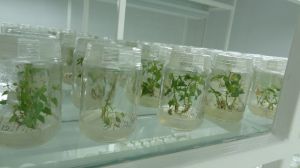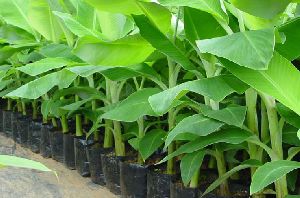
Teak Tissue Culture Plant
Teak (Tectona grandis) is a tropical hardwood tree species placed in the flowering plant family Lamiaceae. Some forms of teak are known as Burmese teak, Central Province teak (CP teak), as well as Nagpur teak. T. grandis is a large, deciduous tree that occurs in mixed hardwood forests. It has small, fragrant white flowers arranged in dense clusters (panicles) at the end of the branches. Tectona grandis is native to south and southeast Asia, mainly Bangladesh, India, Indonesia, Malaysia, Myanmar, Thailand and Sri Lanka, but is naturalised and cultivated in many countries in Africa and the Caribbean. Tectona grandis is found in a variety of habitats and climatic conditions from arid areas with only 500 mm of rain per year to very moist forests with up to 5,000 mm of rain per year. Typically, though, the annual rainfall in areas where teak grows averages 1,250-1,650 mm with a 3-5 month dry season.
Shelf Life : 1 Year
Application : Cutting Boards, Indoor Flooring
Packaging Type : Plastic
Flower Type : Teak Plant
...more
Potato Tissue Culture
The potato is a root vegetable native to the Americas, a starchy tuber of the plant Solanum tuberosum, and the plant itself, a perennial in the family Solanaceae. Today they are a staple food in many parts of the world and an integral part of much of the world’s food supply. As of 2014, potatoes were the world’s fourth-largest food crop after maize (corn), wheat, and rice. Following millennia of selective breeding, there are now over 1,000 different types of potatoes. Potato cultivation in India started after the Portuguese started farming it in the 17th Century in Western India. The importance of the potato farming as a food source and culinary ingredient varies by region and is still changing. It remains an essential crop in Europe, especially Northern and Eastern Europe, where per capita production is still the highest in the world, while the most rapid expansion in production over the past few decades has occurred in southern and eastern Asia, with China and India leading the world in overall production as of 2014. Cultivation of potato in India is widespread. In the central plains of India such as Madhya Pradesh, Gujarat and Orissa, potato is a winter or rabi crop. Therefore, the time of planting here is during the months of October and November. Potato can be both kharif and rabi crop in the Deccan plateau, i.e., in states like Andhra Pradesh, Karnataka and Maharashtra. In other words, two crops of potatoes can be grown in these regions- from mid-June to mid-July and then during October and November. In the southern plains, potatoes are grown throughout the year during summer, autumn and spring. In other words, they are cultivated during April/May, August/September and January.
...more
Pomegranate Tissue Culture Plant
Pomegranate (Punica granatum) is a fruit-bearing deciduous shrub in the family Lythraceae, subfamily Punicoideae, that grows between 5 and 10 m (16 and 33 ft) tall. The fruit is typically in season in the Northern Hemisphere from September to February, and in the Southern Hemisphere from March to May. As intact arils or juice, pomegranates are used in baking, cooking, juice blends, meal garnishes, smoothies, and alcoholic beverages, such as cocktails and wine. The pomegranate originated in the region extending from Iran to northern India. A shrub or small tree growing 5 to 10 m (16 to 33 ft) high, the pomegranate has multiple spiny branches and is extremely long-lived, with some specimens in France surviving for 200 years. P. granatum leaves are opposite or subopposite, glossy, narrow oblong, entire, 3–7 cm (1 1⁄4–2 3⁄4 in) long and 2 cm (3⁄4 in) broad. The flowers are bright red and 3 cm (1.2 in) in diameter, with three to seven petals. Some fruitless varieties are grown for the flowers alone.
Soil Specific : Clay, Alkaline
Application : Agriculture
Height When Fully Grown : 12-15 Feet
...more
Date Palm Tissue Culture Plant
Phoenix dactylifera, commonly known as date or date palm, is a flowering plant species in the palm family, Arecaceae, cultivated for its edible sweet fruit. Although its exact place of origin is uncertain because of long cultivation, it probably originated from the Fertile Crescent region straddling between Egypt and Mesopotamia. The species is widely cultivated across Northern Africa, the Middle East, the Horn of Africa and South Asia, and is naturalized in many tropical and subtropical regions worldwide. P. dactylifera is the species of genus Phoenix, which contains 12–19 species of wild date palm plant varieties, and is the major source of commercial production. A date palm plant typically reaches about 21–23 metres (69–75 ft) in height, growing singly or forming a clump with several stems from a single root system. Date fruits (dates) are oval-cylindrical, 3 to 7 centimetres (1.2 to 2.8 in) long, and about 2.5 centimetres (0.98 in) in diameter, ranging from bright red to bright yellow in colour, depending on the variety. They are very sweet, containing about 75 percent of sugar when dried.
Soil Specific : Clay, Acidic
Application : Agriculture
Height When Fully Grown : 12-15 Feet
...more
Banana Tissue Culture Plant
a banana is an edible fruit – botanically a berry – produced by several kinds of large herbaceous flowering plants in the genus musa. The fruit is variable in size, color, and firmness, but is usually elongated and curved, with soft flesh rich in starch covered with a rind, which may be green, yellow, red, purple, or brown when ripe. The fruits grow in clusters hanging from the top of the plant. banana trees are tropical and hail from rainforests, they need a lot of water and plenty of moisture in the air. Being close together helps them retain moisture in the leaves. The soil should be well-drained, deep, and organically amended. Slightly acidic soil (5.5 to 6.5 ph) is preferred. total annual world production is estimated at 86 million tonnes of fruits. India leads the world in banana production with an annual output of about 14.2 million tonnes.
Application : Agriculture
Height When Fully Grown : 12-15 Feet
Soil Specific : Depending on plant
Other Necessities : Well Watered
...more
Bamboo Tissue Culture Plant
The Bamboo is among the commercially cultivated crops in India, and is also considered as the ‘Poor man’s timber’. India is the second largest producer of Bamboo in the world after China. The annual production in the country is estimated at around 3.23 million tons.The north-eastern states have the most bamboo plantations in India. The Bamboos are evergreen perennial flowering plants in the subfamily Bambusoideae of the grass family Poaceae. There are about 1,200 species of Bamboo, of which 136 are indigenous to India. Bamboo typically grows well in hot to warm temperate climates, where temperatures don’t fall below 15 degree Celsius in the summers. Due to having thin and shallow roots, Bamboos must be sheltered from strong winds. A Bamboo Nursery can grow in a variety of soils except rock-strewn soils. Bamboos also require well drained sandy soil or clay soil, having a pH range of 4.5 to 6.0. The Barack Valley region in Assam is best suited for Bamboo Plantation in India due to best soil and perfect climate. The Indian government is keen on promoting bamboo cultivation. On November 23, it issued an ordinance to categorise cultivated bamboo as non-forest produce that can be transported without transit permits. Maharashtra has also shown interest towards this cause. It is interested in promoting bamboo as a source of income for farmers. In August last year, it created the Maharashtra Bamboo Development Board (MBDB) for this purpose. In India a large area is under Bamboo cultivation—11.4 million hectares, says TSK Reddy, the MBDB’s managing director.
Soil Specific : Acidic, Clay
Application : Agriculture
Height When Fully Grown : 12-15 Feet
...moreBe first to Rate
Rate ThisOpening Hours